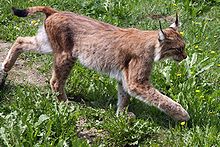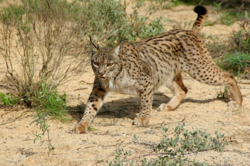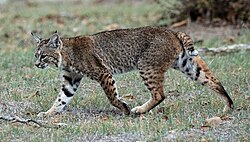Lynx
Script error: The function "automaticTaxobox" does not exist.
A lynx (/ˈ[invalid input: 'ɫ']ɪŋks/;[2] plural lynx or lynxes[3]) is any of the four species within the Lynx genus of medium-sized wild cats. The name "lynx" originated in Middle English via Latin from the Greek word "λύγξ",[2] derived from the Indo-European root "leuk-", meaning "light, brightness",[4] in reference to the luminescence of its reflective eyes.[4]
Neither the caracal, sometimes called the desert lynx, nor the jungle cat, called the jungle lynx, is a member of the Lynx genus.
Appearance
[edit]Lynx have a short tail, characteristic tufts of black hair on the tips of their ears, large, padded paws for walking on snow and long whiskers on the face. Under their neck, they have a ruff which has black bars resembling a bow tie although this often not visible.
Body colour varies from medium brown to goldish to beige-white, and is occasionally marked with dark brown spots, especially on the limbs. All species of lynx have white fur on their chests, bellies and on the insides of their legs, fur which is an extension of the chest and belly fur. The lynx's colouring, fur length and paw size vary according to the climate in their range. In the Southwestern United States, they are short-haired, dark in colour and their paws are smaller and less padded. Lynx in colder northern climates, have progressively thicker fur, the colour gets lighter, their paws are larger and become more padded (for snowy environments). Their paws may be larger than a human hand or foot.
The smallest species are the bobcat and the Canada lynx, while the largest is the Eurasian lynx, with considerable variations within species.
| Species | Weight | Length | Height (standing at shoulders) | |
|---|---|---|---|---|
| Eurasian lynx | males | 18 to 30 kilograms (40 to 66 lb) | 81 to 129 centimetres (32 to 51 in) | 70 centimetres (28 in)[5] |
| females | 18 kilograms (40 lb) | |||
| Canada lynx | 8 to 11 kilograms (18 to 24 lb) | 80 to 105 centimetres (31 to 41 in) | 48 to 56 centimetres (19 to 22 in)[6] | |
| Iberian lynx | males | 12.9 kilograms (28 lb) | 85 to 110 centimetres (33 to 43 in) | 60 to 70 centimetres (24 to 28 in)[7][8][9] |
| females | 9.4 kilograms (21 lb) | |||
| Bobcat | males | 7.3 to 14 kilograms (16 to 31 lb)[10] | 71 to 100 centimetres (28 to 39 in)[10] | 51 to 61 centimetres (20 to 24 in)[11] |
| females | 9.1 kilograms (20 lb) |
Species
[edit]The four living species of the Lynx genus are believed to have evolved from the "Issoire lynx", which lived in Europe and Africa during the late Pliocene to early Pleistocene. The Pliocene felid Felis rexroadensis from North America has been proposed as an even earlier ancestor; however, this was larger than any living species, and is not currently classified as a true lynx.[12]
Eurasian lynx
[edit]
Out of the four lynx species, the Eurasian Lynx (Lynx lynx) is the largest in size. It is native to European and Siberian forests. While its conservation status has been classified as "Least Concern", populations of Eurasian lynx have been reduced or extirpated from Europe, where it is now being reintroduced.
The Eurasian Lynx is the third largest predator in Europe after the brown bear and the grey wolf. It is a strict carnivore, consuming about one or two kilograms of meat every day. The Eurasian Lynx is one of the widest-ranging, and is found in forests of Europe, Russia, and Central Asia.[13]
During the summer, the Eurasian lynx has a relatively short, reddish or brown coat which is replaced by a much thicker silver-grey to greyish-brown coat during winter. The lynx hunts by stalking and jumping its prey, helped by the rugged, forested country in which it resides. A favorite prey for the lynx in its woodland habitat is Roe Deer. It will feed however on whatever animal appears easiest, as it is an opportunistic predator much like its cousins.[12]
Canada lynx
[edit]
The Canada lynx (Lynx canadensis) or Canadian lynx is a North American felid that ranges in forest and tundra regions[14] across Canada and into Alaska, as well as some parts of the northern United States. Historically, the Canadian Lynx ranged from Alaska across Canada and into many of the northern US states. In the eastern states, it resided in the transition zone in which boreal coniferous forests yielded to deciduous forests.[15] By 2010, after an 11-year effort, it had been successfully reintroduced into Colorado, where it had become extirpated in the 1970s.[16][17][18] In 2000, the U.S. Fish and Wildlife Service designated the Canada lynx a threatened species in the lower 48 states.[19]
The Canada lynx is a good climber and swimmer; it constructs rough shelters under fallen trees or rock ledges. It has a thick coat and broad paws, and is twice as effective as bobcats at supporting its weight on the snow. The Canada lynx's diet is almost exclusive to and dependent on snowshoe hares and their numbers. It will also hunt medium-sized mammals and birds if hare numbers fall.[14]
Iberian lynx
[edit]
The Iberian lynx (Lynx pardinus) is a critically endangered species native to the Iberian Peninsula in Southern Europe. It is the most endangered cat species in the world.[20] According to the Portuguese conservation group SOS Lynx, if this species dies out, it will be the first feline extinction since the Smilodon 10,000 years ago.[21] The species used to be classified as a subspecies of the Eurasian lynx, but is now considered a separate species. Both species occurred together in central Europe in the Pleistocene epoch, being separated by habitat choice.[7] The Iberian lynx is believed to have evolved from Lynx issiodorensis.[22]
Bobcat
[edit]
The bobcat (Lynx rufus) is a North American wild cat. With 12 recognized subspecies, the bobcat is common throughout southern Canada, the continental United States, and northern Mexico.[23] The bobcat is an adaptable predator that inhabits deciduous, coniferous, or mixed woodlands, but unlike other Lynx, does not depend exclusively on the deep forest, and ranges from swamps and desert lands to mountainous and agricultural areas, its spotted coat serving as camouflage.[24] The population of the bobcat depends primarily on the population of its prey.[25] Nonetheless, the bobcat is often killed by larger predators such as coyotes.[26]
The bobcat resembles other species of the Lynx genus, but is on average the smallest of the four. Its coat is variable, though generally tan to grayish brown, with black streaks on the body and dark bars on the forelegs and tail. The ears are black-tipped and pointed, with short, black tufts. There is generally an off-white color on the lips, chin, and underparts. Bobcats in the desert regions of the southwest have the lightest-colored coats, while those in the northern, forested regions have the darkest.[11]
Behavior
[edit]The lynx is usually solitary, although a small group of lynx may travel and hunt together occasionally. Mating takes place in the late winter and once a year the female gives birth to between one and four kittens. The gestation time of the lynx is about 70 days. The young stay with the mother for one more winter, a total of around nine months, before moving out to live on their own as young adults. The lynx creates its den in crevices or under ledges. It feeds on a wide range of animals from white-tailed deer, reindeer, roe deer, small red deer, and chamois, to smaller, more usual prey: snowshoe hares, fish, foxes, sheep, squirrels, mice, turkeys and other birds, and goats. It also eats ptarmigans, voles, and grouse.
Distribution and habitat
[edit]The lynx inhabits high altitude forests with dense cover of shrubs, reeds, and tall grass. Although this cat hunts on the ground, it can climb trees and can swim swiftly, catching fish.
Europe and Asia
[edit]The Eurasian lynx ranges from central and northern Europe across Asia up to Northern Pakistan and India. In Iran, they live in Mount Damavand area.[27] Since the beginning of the 20th century, the Eurasian lynx was considered extinct in the wild in Slovenia and Croatia. A resettlement project, begun in 1973, has successfully reintroduced lynx to the Slovenian Alps and the Croatian regions of Gorski Kotar and Velebit, including Croatia's Plitvice Lakes National Park and Risnjak National Park. In both countries, the lynx is listed as an endangered species and protected by law.
Several lynx resettlement projects begun in the 1970s have been successful in various regions of Switzerland. Since the 1990s, there have been numerous efforts to resettle the Eurasian lynx in Germany, and since 2000, a small population can now be found in the Harz mountains near Bad Lauterberg.
The lynx is found in the Białowieża Forest in northeastern Poland, in Estonia and in the northern and western parts of China, particularly the Tibetan Plateau. In Romania, the numbers exceed 2,000, the largest population in Europe outside of Russia, although most experts consider the official population numbers to be overestimated.[28]
The lynx is more common in northern Europe, especially in Norway, Sweden, Estonia, Finland, and the northern parts of Russia. The Swedish population is estimated to be 1200–1500 individuals, spread all over the country, but more common in middle Sweden and in the mountain range. The lynx population in Finland was 1900–2100 individuals in 2008, and the numbers have been increasing every year since 1992. The lynx population in Finland is estimated currently to be larger than ever before.[29] Lynx in Britain were wiped out in the 17th century, but there have been calls to reintroduce them to curb the numbers of deer.[30]
The critically endangered Iberian lynx lives in southern Spain and formerly in eastern Portugal. There is an Iberian lynx reproduction center outside Silves in the Algarve in southern Portugal.
North America
[edit]The two Lynx species in North America, Canada lynx and bobcats, are both found in the temperate zone. While the bobcat is common throughout southern Canada, the continental United States and northern Mexico, the Canada lynx is present mainly in boreal forests of Canada and Alaska.[23]
Protection
[edit]Legal status
[edit]
The hunting of lynx is illegal in many countries. The Iberian lynx is almost extinct and killing it has been outlawed since the 1970s in Spain and Portugal.[31]
Lynx trade is ruled by the CITES (Convention on International Trade in Endangered Species of Wild Fauna and Flora). Some of them are classified in Appendix I (every kind of trade is forbidden) since 1990, others in Appendix II since 1977. The United States asked for deletion of bobcat from Appendix II in 2004 but it has been refused.
Bobcat hunting and trade is regulated domestically throughout its range (Nowell and Jackson 1996). In the United States, bobcats are currently classified as game or furbearer species and subsequently harvested through regulation in 38 States. The species is further protected by continuous closed hunting seasons in 9 States and is classified as a State endangered species in Indiana, Ohio, New Jersey, and Iowa. Bobcats are classified and protected as a State threatened species in Illinois.
In Mexico, bobcat hunting is regulated in 5 states, and shooting suspected livestock predators is permitted on a limited basis (Nowell and Jackson 1996). In Canada, bobcat hunting is also regulated.
Captive breeding
[edit]The Iberian Lynx has been handled by the European Endangered Species Programme, which attempts to coordinate breeding between zoos and maintain genetic diversity. Later, they are meant to be reintroduced to the wild.
Reintroduction
[edit]Fourteen projects of reintroduction have been set in Europe between 1970 and 2006 which gave the best results in Slovenia, the Swiss Alps, Jura, Croatia, Germany, and Italy.
Several lynx resettlement attempts have been tried in the United States in New York and Colorado.
National animal
[edit]The lynx is considered a national animal in the Republic of Macedonia[32][33] and is displayed on the reverse of the 5 denar coin.[34] It is also the national animal of Romania.[35]
See also
[edit]- Lynx (constellation)
- Lynx (mythology)
- Wildcat, a small predator native to Europe, the western part of Asia, and Africa
References
[edit]- ^ Template:MSW3 Wozencraft
- ^ Jump up to: a b "Definition of lynx from Oxford Dictionary". Oxford Dictionary. Retrieved October 5, 2010.
- ^ "lynx — Definition from Longman English Dictionary Online". Longman Dictionary. Retrieved October 5, 2010.
- ^ Jump up to: a b "Lynx". Retrieved October 5, 2010.
- ^ Jackson, Peter (24 April 1997). "Eurasian lynx". lynx.uio.no. Retrieved 2007-05-28.
- ^ "Canada Lynx (Lynx canadensis)". Wisconsin Department of Natural Resources. 2009-07-09. Retrieved 2011-05-29.
- ^ Jump up to: a b "Iberian lynx (Lynx pardinus)" (Page navigation contains an imagemap). Cat Specialist Group Species Accounts. IUCN – The World Conservation Union. 1996. Retrieved 2011-05-29.
- ^ "Iberian lynx – Lynx pardinus". Species Data Sheets. United Nations Environment Programme – World Conservation Monitoring Centre. 2004. Archived from the original on 2010-05-03.
- ^ Johnson, Christopher (2011). "Lynx pardinus – Spanish lynx". Animal Diversity Web. University of Michigan Museum of Zoology. Retrieved 2011-05-29.
- ^ Jump up to: a b Sparano, Vin T. (September 1998). Complete Outdoors Encyclopedia. St. Martin's Press. p. 228. ISBN 0-312-19190-1.
- ^ Jump up to: a b Cahalane, Victor H (2005-03-01). Meeting the Mammals. Kessinger Publishing. p. 64. ISBN 1-4179-9522-X.
- ^ Jump up to: a b Sunquist, Mel; Sunquist, Fiona (2002). Wild cats of the World. Chicago: University of Chicago Press. p. 153. ISBN 0-226-77999-8.
- ^ BBC Nature: Eurasian Lynx. BBC. 2013. Retrieved 2013-01-03.
- ^ Jump up to: a b "Canada lynx, American lynx". Science & Nature: Animals – Wildfacts. BBC. 2008-07-25. Retrieved 2011-05-29.
- ^ "Canada Lynx". Science & Nature: Animals - Wildfacts. National Wildlife Federation. Retrieved 2013-03-01.
- ^
• Banda, P. Solomon (September 18, 2010). "Lynx reintroduction ruled a success in Colorado". The Denver Post. Associated Press. Retrieved September 18, 2010.
• "Colorado: Lynx No Longer Missing". New York Times. Associated Press. 2010-09-17. p. A13. Retrieved 2011-05-29. - ^ "DOW Declares Colorado Lynx Reintroduction Program a Success" (Press release). Colorado Division of Wildlife. September 17, 2010. Retrieved September 18, 2010.
- ^ "Success of the Lynx Reintroduction Program". Colorado Division of Wildlife. Sep 7, 2010. Retrieved September 18, 2010.
- ^ "§ 17.40 Special rules—mammals" (PDF). 65 Federal Register 16051 16086. National Archives and Records Administration. 2000-03-24. p. 35. Retrieved 2011-05-30.
- ^ Ward, Dan (2008-12-12). "LynxBrief" (PDF). IberiaNature. Retrieved 2011-05-30.
- ^ Gonçalves, Eduardo (2002-04-21). "Captured cubs hold future of Europe's tiger". London: The Guardian. Retrieved 2010-11-14.
- ^ Kurtén, Björn (1968). Pleistocene Mammals of Europe.
- ^ Jump up to: a b Zielinski, William J.; Kucera, Thomas E. (1998). American Marten, Fisher, Lynx, and Wolverine: Survey Methods for Their Detection. USA: Diane Publishing. p. 74. ISBN 978-0-7881-3628-3.
- ^ Hamilton, William J.; Whitaker, John O. (1998). Mammals of the Eastern United States. Cornell University Press. pp. 493–496. ISBN 0-8014-3475-0.
- ^ "Deletion of Bobcat (Lynx rufus) from Appendix II" (PDF). Thirteenth Meeting of the Conference of the Parties, Proposal 5. Convention on International Trade in Endangered Species of Wild Fauna and Flora. October 2004. Retrieved 2007-05-31.
- ^ Fedriani, J. M., T. K. Fuller, R. M. Sauvajot and E. C. York. 2000. Competition and intraguild predation among three sympatric carnivores. Oecologia, 125:258–270.
- ^ "Iran Envrionmental and Wild life Watch" http://www.iew.ir/1392/10/21/20008
- ^ "Status and conservation of the Eurasian Lynx (Lynx lynx) in Europe in 2001" (PDF [17.09 Mb]). Coordinated research projects for the conservation and management of carnivores in Switzerland (KORA). Retrieved 2014-01-08.
- ^ "Ilves" (in Finnish). Finland: Riista- ja kalatalouden tutkimuslaitos. 2010-10-14. Retrieved 2011-05-30.
- ^ Moore, Matthew (2009-02-13). "Lynx 'should be reintroduced to Britain to cull deer'". London: Telegraph.co.uk. Retrieved 2010-11-14.
- ^ Ward, Dan (2004). "The Iberian Lynx Emergency" (PDF). Retrieved 2007-05-13.
- ^ Testorides, Konstantin (2006-11-04). "Macedonia Wildcats Fight for Survival". Washington Post. Associated Press. Retrieved 2011-05-30.
- ^ Mironski, Jasmina (2009-02-25). "On the trail of the Balkan Lynx". Eathimerini. Agence France-Presse. Retrieved 2011-05-30.
The lynx is one of the most endangered wild species and is considered as a national symbol of the country
- ^ "National Bank of Macedonia – Coins in circulation". Nbrm.gov.mk. 2008-11-15. Retrieved 2010-11-14.
- ^ http://www.9am.ro/top/Social/243039/sapte-simboluri-nationale-mai-putin-cunoscute-romania/2/Animalul-national-Rasul.html
External links
[edit]![]() Media related to Lynx at Wikimedia Commons
Template:Wikispecies
Media related to Lynx at Wikimedia Commons
Template:Wikispecies
- SOS Lynx: Photos, news and information about the Iberian lynx in English and Portuguese
- Canada lynx in the southern Rockies
- The Iberian Lynx The natural history of the Iberian lynx
- The Nature Conservatory's Species Profile: Lynx
- Canada lynx (U.S. Fish & Wildlife Service)
- Lynx research in the Bavarian Forest National Park
- Forest Service lynx research – RMRS
- Smithsonian Magazine: Tracking The Elusive Lynx
- CONVENTION ON INTERNATIONAL TRADE IN ENDANGERED SPECIES OF WILD FAUNA AND FLORA
- Pages with script errors
- Pages using the JsonConfig extension
- CS1 Finnish-language sources (fi)
- Wikipedia introduction cleanup from March 2015
- Articles with invalid date parameter in template
- All pages needing cleanup
- Articles covered by WikiProject Wikify from March 2015
- All articles covered by WikiProject Wikify
- Wikipedia pages with incorrect protection templates
- Articles with hatnote templates targeting a nonexistent page
- Ill-formatted IPAc-en transclusions
- Lynx
- Mammal genera
